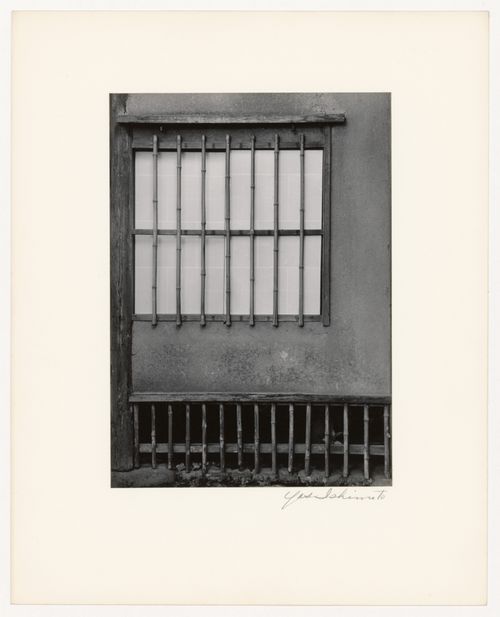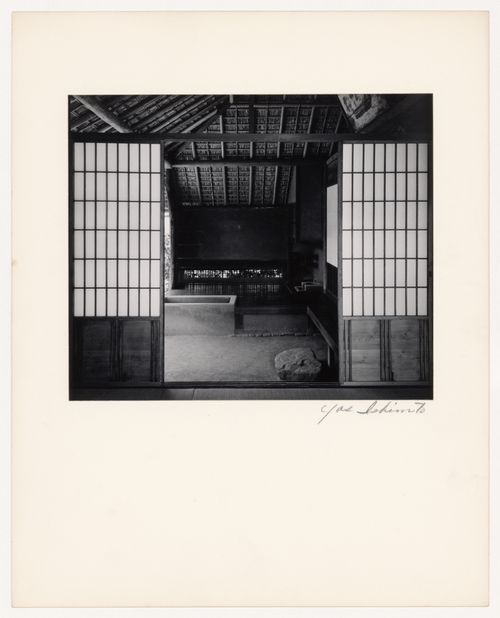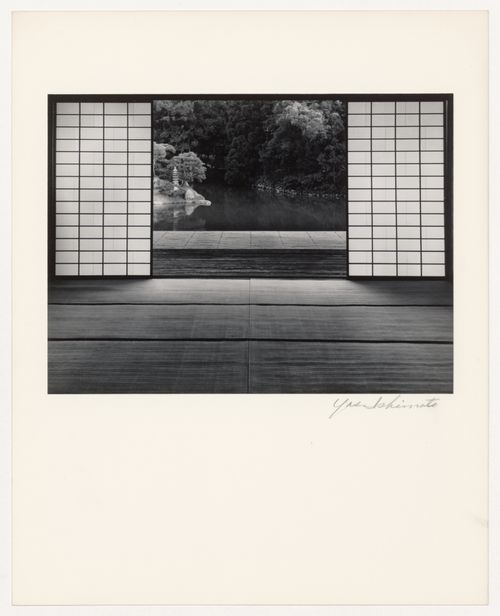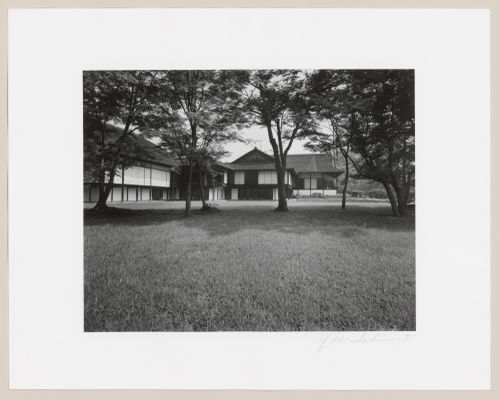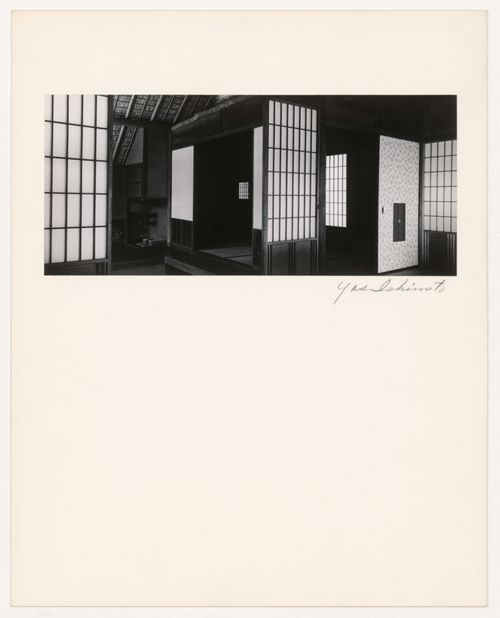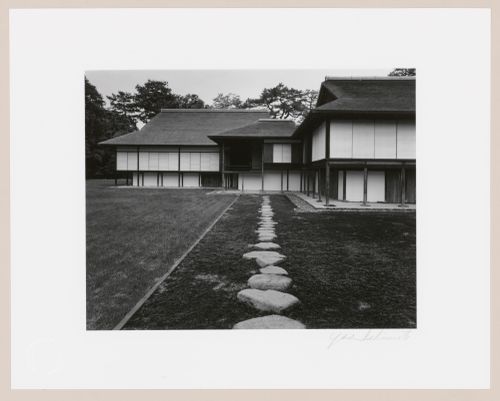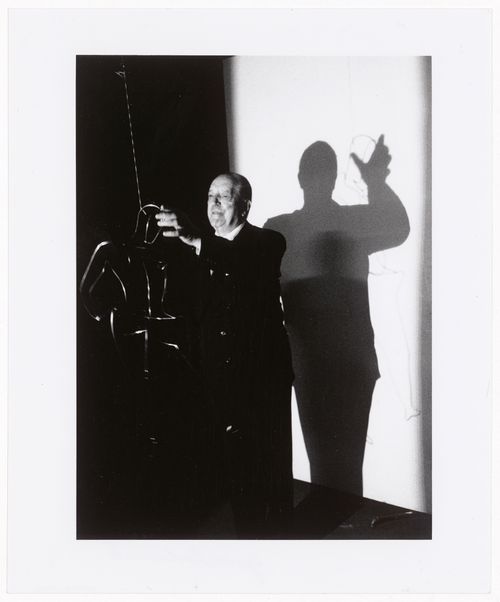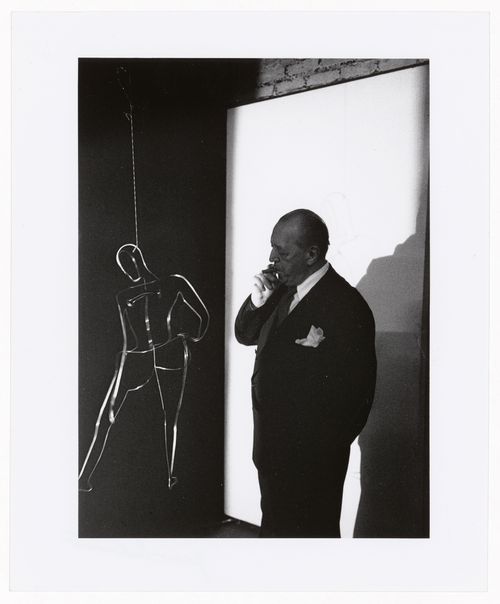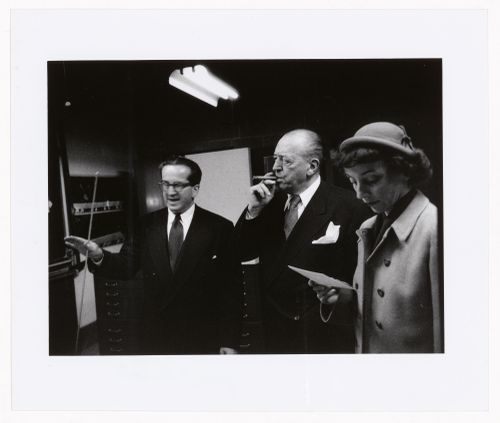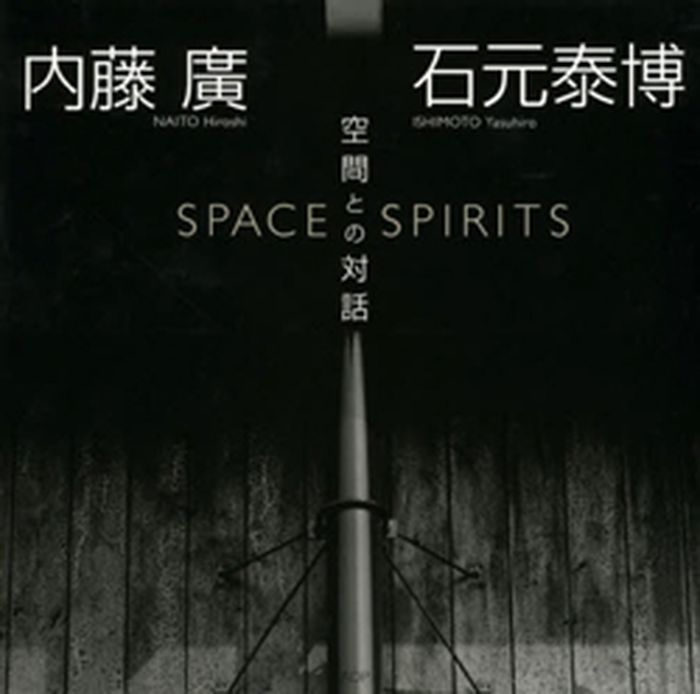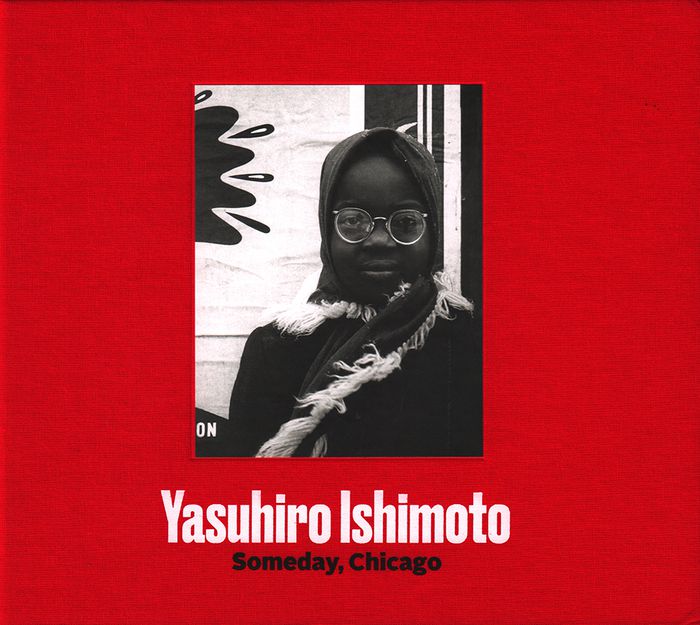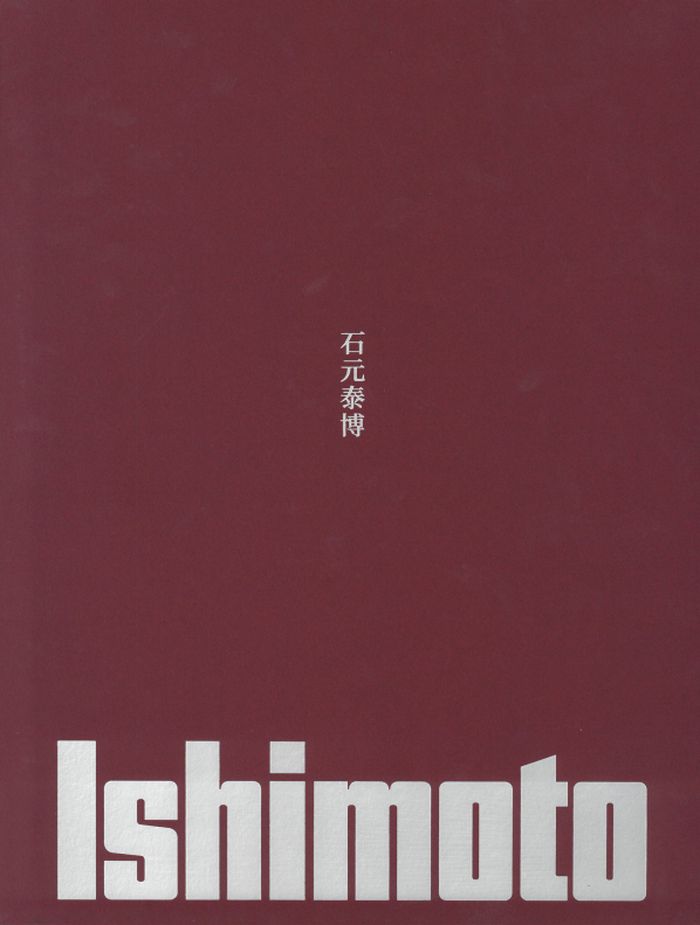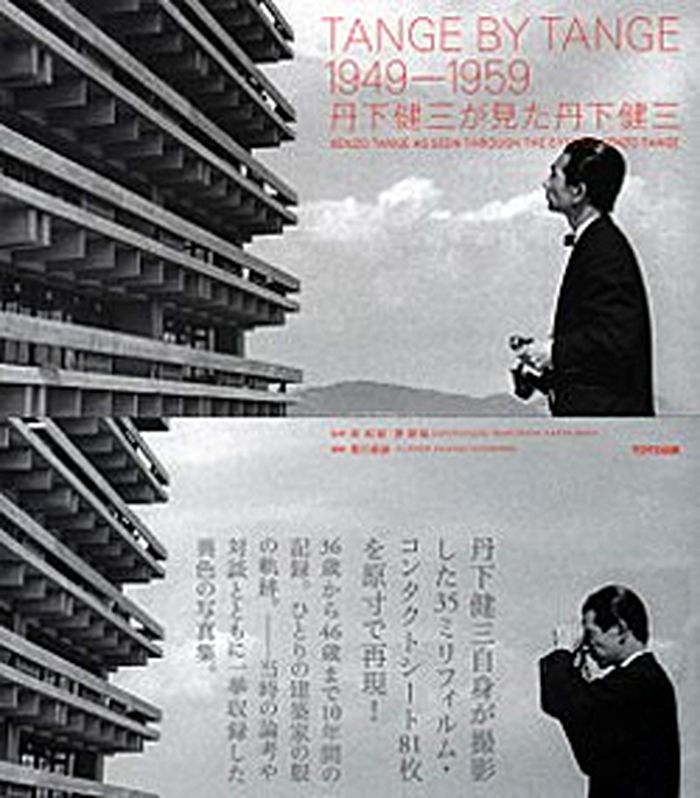PH1986:0195
Description:
- Photographs PH1986:0148 - PH1986:0283 form a sequence of views. Accession numbers follow an order established by the photographer that is based on the temporal experience of walking through the grounds of Katsura Rikyu (also known as Katsura Imperial Villa) (see acquisition file). - After first photographing Katsura Rikyu (also known as Katsura Imperial Villa) in 1953, Yasuhiro Ishimoto returned there in 1982 and took another series of photographs, this time with many in colour, often using the same or very similar views to those of his 1953 photographs (Ishimoto, pp. 265-266). - The south lawn (also known as the court football [kemari] field) is visible in the foreground (Isozaki, et al, pp. 68-69, repr.; p. 244; Ito, site plan).
architecture, architecture de paysage
1982
View of the Shoin complex showing the Old Shoin, the Middle Shoin and the New Palace (also known as the New Goten), Katsura Rikyu (also known as Katsura Imperial Villa), Kyoto, Japan
Actions:
PH1986:0195
Description:
- Photographs PH1986:0148 - PH1986:0283 form a sequence of views. Accession numbers follow an order established by the photographer that is based on the temporal experience of walking through the grounds of Katsura Rikyu (also known as Katsura Imperial Villa) (see acquisition file). - After first photographing Katsura Rikyu (also known as Katsura Imperial Villa) in 1953, Yasuhiro Ishimoto returned there in 1982 and took another series of photographs, this time with many in colour, often using the same or very similar views to those of his 1953 photographs (Ishimoto, pp. 265-266). - The south lawn (also known as the court football [kemari] field) is visible in the foreground (Isozaki, et al, pp. 68-69, repr.; p. 244; Ito, site plan).
architecture, architecture de paysage
PH1986:0257
Description:
- Photographs PH1986:0148 - PH1986:0283 form a sequence of views. Accession numbers follow an order established by the photographer that is based on the temporal experience of walking through the grounds of Katsura Rikyu (also known as Katsura Imperial Villa) (see acquisition file). - Yasuhiro Ishimoto returned to Katsura Rikyu (also known as Katsura Imperial Villa) in 1982 and took another series of photographs, this time with many in colour, often using the same or very similar views to those of his 1953 photographs at the same location (Ishimoto, p. 266).
architecture, architecture de paysage
1953
View of the north entrance of the Shoiken showing stepping-stones, Katsura Rikyu (also known as Katsura Imperial Villa), Kyoto, Japan
Actions:
PH1986:0257
Description:
- Photographs PH1986:0148 - PH1986:0283 form a sequence of views. Accession numbers follow an order established by the photographer that is based on the temporal experience of walking through the grounds of Katsura Rikyu (also known as Katsura Imperial Villa) (see acquisition file). - Yasuhiro Ishimoto returned to Katsura Rikyu (also known as Katsura Imperial Villa) in 1982 and took another series of photographs, this time with many in colour, often using the same or very similar views to those of his 1953 photographs at the same location (Ishimoto, p. 266).
architecture, architecture de paysage
PH1986:0241
Description:
- Photographs PH1986:0148 - PH1986:0283 form a sequence of views. Accession numbers follow an order established by the photographer that is based on the temporal experience of walking through the grounds of Katsura Rikyu (also known as Katsura Imperial Villa) (see acquisition file). - After first photographing Katsura Rikyu (also known as Katsura Imperial Villa) in 1953, Yasuhiro Ishimoto returned there in 1982 and took another series of photographs, this time with many in colour, often using the same or very similar views to those of his 1953 photographs (Ishimoto, pp. 265-266). - This photograph was taken from the veranda of the Shokintei looking in to the First Room (Isozaki, et al, p. 169, repr.; pp. 253-254).
architecture, design d'intérieur, peinture
1982
Interior view of the First Room of the Shokintei showing the tokonoma [alcove], Katsura Rikyu (also known as Katsura Imperial Villa), Kyoto, Japan
Actions:
PH1986:0241
Description:
- Photographs PH1986:0148 - PH1986:0283 form a sequence of views. Accession numbers follow an order established by the photographer that is based on the temporal experience of walking through the grounds of Katsura Rikyu (also known as Katsura Imperial Villa) (see acquisition file). - After first photographing Katsura Rikyu (also known as Katsura Imperial Villa) in 1953, Yasuhiro Ishimoto returned there in 1982 and took another series of photographs, this time with many in colour, often using the same or very similar views to those of his 1953 photographs (Ishimoto, pp. 265-266). - This photograph was taken from the veranda of the Shokintei looking in to the First Room (Isozaki, et al, p. 169, repr.; pp. 253-254).
architecture, design d'intérieur, peinture
PH1986:0231
Description:
- Photographs PH1986:0148 - PH1986:0283 form a sequence of views. Accession numbers follow an order established by the photographer that is based on the temporal experience of walking through the grounds of Katsura Rikyu (also known as Katsura Imperial Villa) (see acquisition file). - Yasuhiro Ishimoto returned to Katsura Rikyu (also known as Katsura Imperial Villa) in 1982 and took another series of photographs, this time with many in colour, often using the same or very similar views to those of his 1953 photographs at the same location (Ishimoto, p. 266). - The title of a published identical image, "Grille window of the Shoiken" is inaccurate, as the Shoiken is situated on the opposite side of Katsura Rikyu (also known as Katsura Imperial Villa) from the building shown in this view (Ito, p. 128, site plan).
architecture
1953
View of a window with shoji and bamboo mullions on the northeast wall of the Shokintei, Katsura Rikyu (also known as Katsura Imperial Villa), Kyoto, Japan
Actions:
PH1986:0231
Description:
- Photographs PH1986:0148 - PH1986:0283 form a sequence of views. Accession numbers follow an order established by the photographer that is based on the temporal experience of walking through the grounds of Katsura Rikyu (also known as Katsura Imperial Villa) (see acquisition file). - Yasuhiro Ishimoto returned to Katsura Rikyu (also known as Katsura Imperial Villa) in 1982 and took another series of photographs, this time with many in colour, often using the same or very similar views to those of his 1953 photographs at the same location (Ishimoto, p. 266). - The title of a published identical image, "Grille window of the Shoiken" is inaccurate, as the Shoiken is situated on the opposite side of Katsura Rikyu (also known as Katsura Imperial Villa) from the building shown in this view (Ito, p. 128, site plan).
architecture
PH1986:0273
Description:
- Photographs PH1986:0148 - PH1986:0283 form a sequence of views. Accession numbers follow an order established by the photographer that is based on the temporal experience of walking through the grounds of Katsura Rikyu (also known as Katsura Imperial Villa) (see acquisition file). - Yasuhiro Ishimoto returned to Katsura Rikyu (also known as Katsura Imperial Villa) in 1982 and took another series of photographs, this time with many in colour, often using the same or very similar views to those of his 1953 photographs at the same location (Ishimoto, p. 266). - This photograph shows the Pantry (also known as the Preparation Area for the Tea Ceremony) in the background, the loggia in the middle gound and the Second Room (also known as the Middle Room) in the foreground (Isozaki, et al, p. 227, repr.; p. 257; Tange, n.p., plan).
architecture, design d'intérieur
1953
Interior view of the Gepparo showing the Pantry (also known as the Preparation Area for the Tea Ceremony), the loggia and the Second Room (also known as the Middle Room), Katsura Rikyu (also known as Katsura Imperial Villa), Kyoto, Japan
Actions:
PH1986:0273
Description:
- Photographs PH1986:0148 - PH1986:0283 form a sequence of views. Accession numbers follow an order established by the photographer that is based on the temporal experience of walking through the grounds of Katsura Rikyu (also known as Katsura Imperial Villa) (see acquisition file). - Yasuhiro Ishimoto returned to Katsura Rikyu (also known as Katsura Imperial Villa) in 1982 and took another series of photographs, this time with many in colour, often using the same or very similar views to those of his 1953 photographs at the same location (Ishimoto, p. 266). - This photograph shows the Pantry (also known as the Preparation Area for the Tea Ceremony) in the background, the loggia in the middle gound and the Second Room (also known as the Middle Room) in the foreground (Isozaki, et al, p. 227, repr.; p. 257; Tange, n.p., plan).
architecture, design d'intérieur
PH1986:0199
Description:
- Photographs PH1986:0148 - PH1986:0283 form a sequence of views. Accession numbers follow an order established by the photographer that is based on the temporal experience of walking through the grounds of Katsura Rikyu (also known as Katsura Imperial Villa) (see acquisition file). - Yasuhiro Ishimoto returned to Katsura Rikyu (also known as Katsura Imperial Villa) in 1982 and took another series of photographs, this time with many in colour, often using the same or very similar views to those of his 1953 photographs at the same location (Ishimoto, p. 266). - This photograph was taken from inside the Second Room of the Old Shoin looking out over the broad veranda and the Moon-viewing Platform to the pond and the garden beyond (Isozaki, et al, pp. 74-75, repr.; p. 244; Ito, p. 42, 79-80, site plan).
architecture, architecture de paysage
1953
View of the Moon-viewing Platform, the pond and the garden showing the Second Room of the Old Shoin in the foreground, Katsura Rikyu (also known as Katsura Imperial Villa), Kyoto, Japan
Actions:
PH1986:0199
Description:
- Photographs PH1986:0148 - PH1986:0283 form a sequence of views. Accession numbers follow an order established by the photographer that is based on the temporal experience of walking through the grounds of Katsura Rikyu (also known as Katsura Imperial Villa) (see acquisition file). - Yasuhiro Ishimoto returned to Katsura Rikyu (also known as Katsura Imperial Villa) in 1982 and took another series of photographs, this time with many in colour, often using the same or very similar views to those of his 1953 photographs at the same location (Ishimoto, p. 266). - This photograph was taken from inside the Second Room of the Old Shoin looking out over the broad veranda and the Moon-viewing Platform to the pond and the garden beyond (Isozaki, et al, pp. 74-75, repr.; p. 244; Ito, p. 42, 79-80, site plan).
architecture, architecture de paysage
PH1986:0174
Description:
- Photographs PH1986:0148 - PH1986:0283 form a sequence of views. Accession numbers follow an order established by the photographer that is based on the temporal experience of walking through the grounds of Katsura Rikyu (also known as Katsura Imperial Villa) (see acquisition file). - Yasuhiro Ishimoto returned to Katsura Rikyu (also known as Katsura Imperial Villa) in 1982 and took another series of photographs, this time with many in colour, often using the same or very similar views to those of his 1953 photographs at the same location (Ishimoto, p. 266). - This photograph was taken from the south lawn (also known as the court football [kemari] field), showing the New Palace (also known as the New Goten), the Music Room, the Middle Shoin and the Old Shoin, from left to right (Tange, p. 12; Isozaki, et al, pp. 68-69, repr.).
architecture, architecture de paysage
1953
View of the New Palace (also known as the New Goten), the Music Room, the Middle Shoin and the Old Shoin, Katsura Rikyu (also known as Katsura Imperial Villa), Kyoto, Japan
Actions:
PH1986:0174
Description:
- Photographs PH1986:0148 - PH1986:0283 form a sequence of views. Accession numbers follow an order established by the photographer that is based on the temporal experience of walking through the grounds of Katsura Rikyu (also known as Katsura Imperial Villa) (see acquisition file). - Yasuhiro Ishimoto returned to Katsura Rikyu (also known as Katsura Imperial Villa) in 1982 and took another series of photographs, this time with many in colour, often using the same or very similar views to those of his 1953 photographs at the same location (Ishimoto, p. 266). - This photograph was taken from the south lawn (also known as the court football [kemari] field), showing the New Palace (also known as the New Goten), the Music Room, the Middle Shoin and the Old Shoin, from left to right (Tange, p. 12; Isozaki, et al, pp. 68-69, repr.).
architecture, architecture de paysage
PH1986:0270
Description:
- Photographs PH1986:0148 - PH1986:0283 form a sequence of views. Accession numbers follow an order established by the photographer that is based on the temporal experience of walking through the grounds of Katsura Rikyu (also known as Katsura Imperial Villa) (see acquisition file). - Yasuhiro Ishimoto returned to Katsura Rikyu (also known as Katsura Imperial Villa) in 1982 and took another series of photographs, this time with many in colour, often using the same or very similar views to those of his 1953 photographs at the same location (Ishimoto, p. 266). - This photograph shows the Pantry (also known as the Preparation Area for the Tea Ceremony), the loggia and the First Room, from left to right, and the Second Room (also known as the Middle Room) in the foreground (Isozaki, et al, pp. 222-223, repr.; p. 257; Tange, n.p., plan).
architecture, design d'intérieur
1953
Interior view of the Gepparo showing the Pantry (also known as the Preparation Area for the Tea Ceremony), the loggia, the First Room and the Second Room (also known as the Middle Room), Katsura Rikyu (also known as Katsura Imperial Villa), Kyoto, Japan
Actions:
PH1986:0270
Description:
- Photographs PH1986:0148 - PH1986:0283 form a sequence of views. Accession numbers follow an order established by the photographer that is based on the temporal experience of walking through the grounds of Katsura Rikyu (also known as Katsura Imperial Villa) (see acquisition file). - Yasuhiro Ishimoto returned to Katsura Rikyu (also known as Katsura Imperial Villa) in 1982 and took another series of photographs, this time with many in colour, often using the same or very similar views to those of his 1953 photographs at the same location (Ishimoto, p. 266). - This photograph shows the Pantry (also known as the Preparation Area for the Tea Ceremony), the loggia and the First Room, from left to right, and the Second Room (also known as the Middle Room) in the foreground (Isozaki, et al, pp. 222-223, repr.; p. 257; Tange, n.p., plan).
architecture, design d'intérieur
PH1986:0271
Description:
- Photographs PH1986:0148 - PH1986:0283 form a sequence of views. Accession numbers follow an order established by the photographer that is based on the temporal experience of walking through the grounds of Katsura Rikyu (also known as Katsura Imperial Villa) (see acquisition file). - Yasuhiro Ishimoto returned to Katsura Rikyu (also known as Katsura Imperial Villa) in 1982 and took another series of photographs, this time with many in colour, often using the same or very similar views to those of his 1953 photographs at the same location (Ishimoto, p. 266). - This photograph shows the Pantry (also known as the Preparation Area for the Tea Ceremony) and the First Room, from left to right, and the Second Room (also known as the Middle Room) in the foreground (Isozaki, et al, pp. 222-223, repr.; p. 257; Tange, n.p., plan).
architecture, design d'intérieur
1953
Interior view of the Gepparo showing the Pantry (also known as the Preparation Area for the Tea Ceremony), the First Room and the Second Room (also known as the Middle Room), Katsura Rikyu (also known as Katsura Imperial Villa), Kyoto, Japan
Actions:
PH1986:0271
Description:
- Photographs PH1986:0148 - PH1986:0283 form a sequence of views. Accession numbers follow an order established by the photographer that is based on the temporal experience of walking through the grounds of Katsura Rikyu (also known as Katsura Imperial Villa) (see acquisition file). - Yasuhiro Ishimoto returned to Katsura Rikyu (also known as Katsura Imperial Villa) in 1982 and took another series of photographs, this time with many in colour, often using the same or very similar views to those of his 1953 photographs at the same location (Ishimoto, p. 266). - This photograph shows the Pantry (also known as the Preparation Area for the Tea Ceremony) and the First Room, from left to right, and the Second Room (also known as the Middle Room) in the foreground (Isozaki, et al, pp. 222-223, repr.; p. 257; Tange, n.p., plan).
architecture, design d'intérieur
PH1986:0193
Description:
- Photographs PH1986:0148 - PH1986:0283 form a sequence of views. Accession numbers follow an order established by the photographer that is based on the temporal experience of walking through the grounds of Katsura Rikyu (also known as Katsura Imperial Villa) (see acquisition file). - After first photographing Katsura Rikyu (also known as Katsura Imperial Villa) in 1953, Yasuhiro Ishimoto returned there in 1982 and took another series of photographs, this time with many in colour, often using the same or very similar views to those of his 1953 photographs (Ishimoto, pp. 265-266). - This photograph shows the south lawn (also known as the court football [kemari] field) in the foreground, at left, and the moss garden in the foreground, at right (Isozaki, et al, pp. 52-53, repr.; pp. 68-69, repr.; pp. 78, repr.; p. 244; Ito, site plan; Tange, n.p., plan).
architecture, architecture de paysage
1982
View of the New Palace (also known as the New Goten), the Music Room and the Middle Shoin showing stepping-stones in the foreground, Katsura Rikyu (also known as Katsura Imperial Villa), Kyoto, Japan
Actions:
PH1986:0193
Description:
- Photographs PH1986:0148 - PH1986:0283 form a sequence of views. Accession numbers follow an order established by the photographer that is based on the temporal experience of walking through the grounds of Katsura Rikyu (also known as Katsura Imperial Villa) (see acquisition file). - After first photographing Katsura Rikyu (also known as Katsura Imperial Villa) in 1953, Yasuhiro Ishimoto returned there in 1982 and took another series of photographs, this time with many in colour, often using the same or very similar views to those of his 1953 photographs (Ishimoto, pp. 265-266). - This photograph shows the south lawn (also known as the court football [kemari] field) in the foreground, at left, and the moss garden in the foreground, at right (Isozaki, et al, pp. 52-53, repr.; pp. 68-69, repr.; pp. 78, repr.; p. 244; Ito, site plan; Tange, n.p., plan).
architecture, architecture de paysage
PH2005:0002
1951
PH2005:0003
1951
PH2005:0004
1951
$125.00
(disponible sur commande)
Résumé:
With Toba Sea-Folk Museum as its primary subject, this overview of four works by Japanese architect Hiroshi Naito centres upon the black-and-white images made by renowned photographer Yasuhiro Ishimoto. Upon Naitos request, Ishimoto photographed each project in detail, capturing the moment when a particular light manifests at a certain place, when nature and building fall(...)
Yasuhiro Ishimoto: Space Spirits
Actions:
Prix:
$125.00
(disponible sur commande)
Résumé:
With Toba Sea-Folk Museum as its primary subject, this overview of four works by Japanese architect Hiroshi Naito centres upon the black-and-white images made by renowned photographer Yasuhiro Ishimoto. Upon Naitos request, Ishimoto photographed each project in detail, capturing the moment when a particular light manifests at a certain place, when nature and building fall into dialogue. In his writings, Naito not only lends detailed insight regarding his works, but also expresses his gratitude for the photographers keen eye, the warmth inherent in buildings, and the refined intervention of human endeavour in the natural landscape.
Monographies photo
$48.00
(disponible sur commande)
Résumé:
This book examines the work of US-born photographer Yasuhiro Ishimoto (1921–2012) through its connections to Chicago, where he lived for over a decade and returned to repeatedly throughout his life. Long celebrated in Japan as one of the most influential photographers of the twentieth century, Ishimoto also maintained deep ties to his adopted home city of Chicago, where(...)
Yasuhiro Ishimoto: Someday, Chicago
Actions:
Prix:
$48.00
(disponible sur commande)
Résumé:
This book examines the work of US-born photographer Yasuhiro Ishimoto (1921–2012) through its connections to Chicago, where he lived for over a decade and returned to repeatedly throughout his life. Long celebrated in Japan as one of the most influential photographers of the twentieth century, Ishimoto also maintained deep ties to his adopted home city of Chicago, where he arrived in 1945 after having been imprisoned in a US internment camp during WWII. It was in Chicago that he developed his uniquely modernist vision in two key ways. First, he created works that engaged in important conversation with that of Laszlo Moholy-Nagy, Harry Callahan, Aaron Siskind, and others at the historic Institute of Design. Second, he immersed himself directly in the city's neighborhoods, where he captured important social changes reflective of broader shifts elsewhere in the US.
Monographies photo
$190.95
(disponible sur commande)
Résumé:
« Ishimoto. Des lignes et des corps » présente les séries emblématiques de Yasuhiro Ishimoto (1921-2012) qui allient l’approche formelle du New Bauhaus de Chicago à la quintessence de l’esthétique japonaise. Cette monographie permet de redécouvrir l’oeuvre d'un photographe très peu publié de son vivant. La singularité de son regard et son travail sur le motif, allant(...)
Ishimoto : Des lignes et des corps
Actions:
Prix:
$190.95
(disponible sur commande)
Résumé:
« Ishimoto. Des lignes et des corps » présente les séries emblématiques de Yasuhiro Ishimoto (1921-2012) qui allient l’approche formelle du New Bauhaus de Chicago à la quintessence de l’esthétique japonaise. Cette monographie permet de redécouvrir l’oeuvre d'un photographe très peu publié de son vivant. La singularité de son regard et son travail sur le motif, allant parfois jusqu’à l’abstraction, ont fait d'Ishimoto une figure incontournable du monde de l’art qui a bouleversé la scène photographique japonaise dans les années 1960. Conçu en étroite collaboration avec le Ishimoto Yasuhiro Photo Center, cet ouvrage accompagne l’exposition éponyme présentée au BAL sous le commissariat de Diane Dufour avec Mei Asakura, directrice des Archives. Largement considéré comme étranger par ses pairs, Ishimoto importe une perspective formaliste sur la scène photographique japonaise de l’époque. Scènes de rues, portraits d’enfants déguisés pour Halloween, panneaux publicitaires, façades d’immeubles de quartiers populaires : ses images témoignent de sa maîtrise du cadrage ainsi que de sa perception sensible des textures et des motifs.
Monographies photo
$295.00
(disponible sur commande)
Résumé:
One of the 20th century’s most significant architects, Kenzo Tange combined traditional Japanese styles with modernism, and took on major post-war urban redevelopment projects in Tokyo and abroad. In 1960, Tange – together with photographer Yasuhiro Ishimoto, architect Walter Gropius, and graphic designer Herbert Bayer – published a photobook titled ‘Katsura’, in which he(...)
Tange by Tange, 1949-1959. Kenzo Tange as seen though the eyes of Kenzo
Actions:
Prix:
$295.00
(disponible sur commande)
Résumé:
One of the 20th century’s most significant architects, Kenzo Tange combined traditional Japanese styles with modernism, and took on major post-war urban redevelopment projects in Tokyo and abroad. In 1960, Tange – together with photographer Yasuhiro Ishimoto, architect Walter Gropius, and graphic designer Herbert Bayer – published a photobook titled ‘Katsura’, in which he questioned the conventional historical perspectives on Japanese architecture. Many previously unpublished photographs taken by Tange during the 1950s now appear in this remarkably arranged volume, giving insight to his later works. With an introduction by Saikaku Toyokawa and texts by Kenzo Tange.
Architecture, monographies
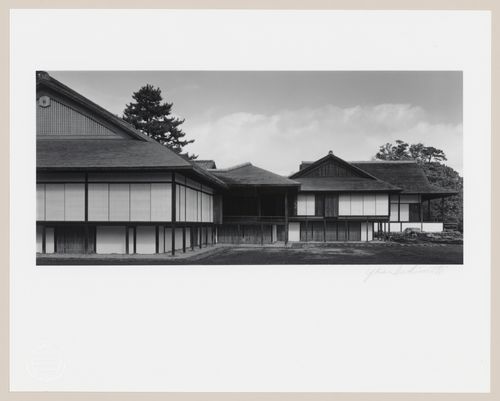
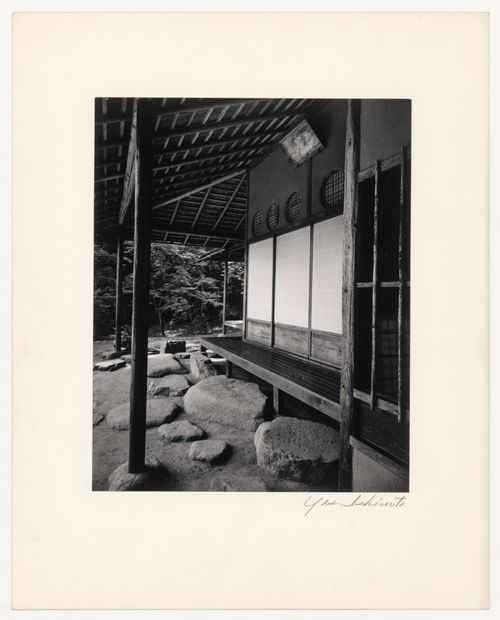
![Interior view of the First Room of the Shokintei showing the tokonoma [alcove], Katsura Rikyu (also known as Katsura Imperial Villa), Kyoto, Japan](/img-collection/DFOZBjAr1jQfnlV6LVs34UhvLXI=/500x401/362780.jpg)
